
Rediscovering Japan

Rediscovering Japan
Seasonal Events (May)

by tomizuta
Children's Day
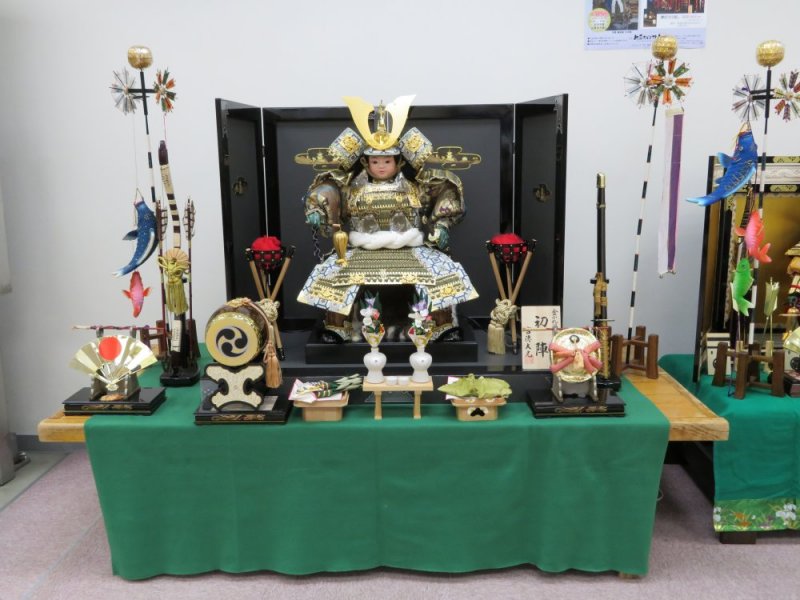 Childrenfs Day on the 5th of May is a national holiday. Although called Childrenfs Day, it has been regarded a boyfs day. Historically there were five days called Sekku in a year at which junctures there would be a change in the season. We imported this from the Chinese in most likely the 6th or 7th century. In January we enjoy the seven wild vegetables, March peach flowers, May iris, July bamboo and chrysanthemum in September. These days were designated under the lunar calendar, but came to be practiced on the same dates under the solar calendar.
Childrenfs Day on the 5th of May is a national holiday. Although called Childrenfs Day, it has been regarded a boyfs day. Historically there were five days called Sekku in a year at which junctures there would be a change in the season. We imported this from the Chinese in most likely the 6th or 7th century. In January we enjoy the seven wild vegetables, March peach flowers, May iris, July bamboo and chrysanthemum in September. These days were designated under the lunar calendar, but came to be practiced on the same dates under the solar calendar.
(Left: A typical Children's Day display for boys depicting a samurai at
his first battle. At Sawara Machinami Kouryuukan, a community center promoting
the preservation of the historic districts of Sawara City in a building
constructed in 1917 and formerly a bank.)
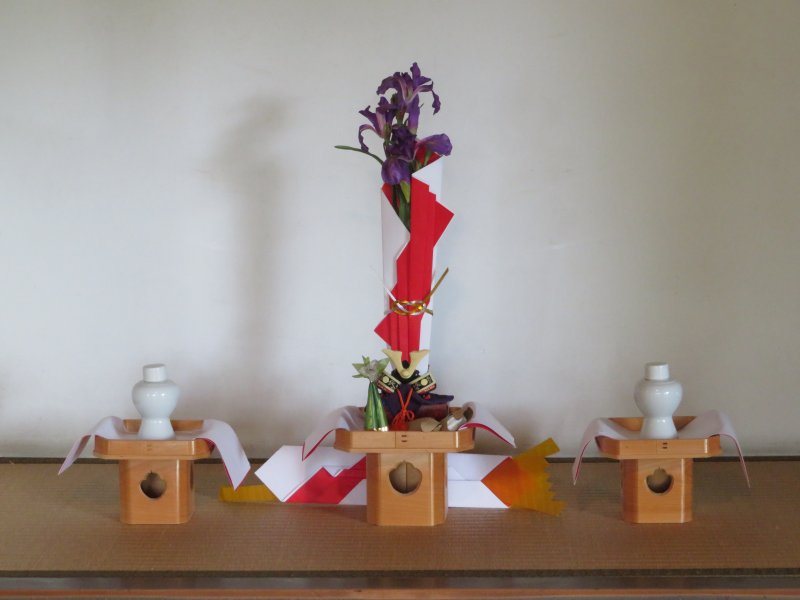 May is the time to prepare for rice planting. It is thought that the celebration in May originated from a ritual to purify oneself from evil in preparation for rice planting It was believed that irises had the power to purify. Iris in Japanese is Shoubu, the same pronunciation of which could mean encouraging martial arts. It is said that this is why the ritual in May was converted definitely by the Edo era as a day to wish for the wellbeing of boys.
May is the time to prepare for rice planting. It is thought that the celebration in May originated from a ritual to purify oneself from evil in preparation for rice planting It was believed that irises had the power to purify. Iris in Japanese is Shoubu, the same pronunciation of which could mean encouraging martial arts. It is said that this is why the ritual in May was converted definitely by the Edo era as a day to wish for the wellbeing of boys.
( Left: A Children's Day display of the prominent Ogasawara Family. Note
the iris (shoubu) in the center. At the former Ando Family residence in
Minami Alps City, Yamanashi Prefecture.)
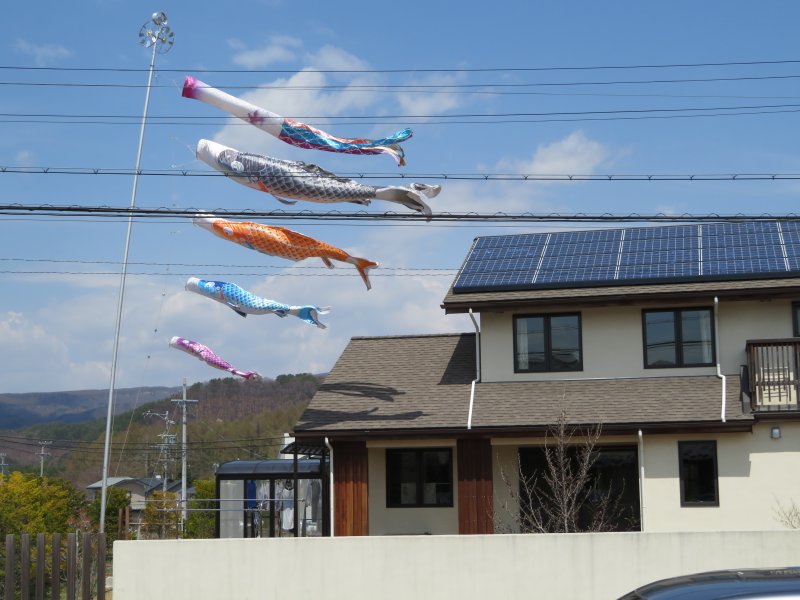 Children's Day is usually celebrated by displaying Samurai armory and carp streamers. Although it used to be a boyfs day, it was named Childrenfs Day after WWII.
Children's Day is usually celebrated by displaying Samurai armory and carp streamers. Although it used to be a boyfs day, it was named Childrenfs Day after WWII.
(Left: Carp streamers soaring the skies in Chino City, Nagano Prefecture.
Such displays are difficult to find nowadays in the large cities.)
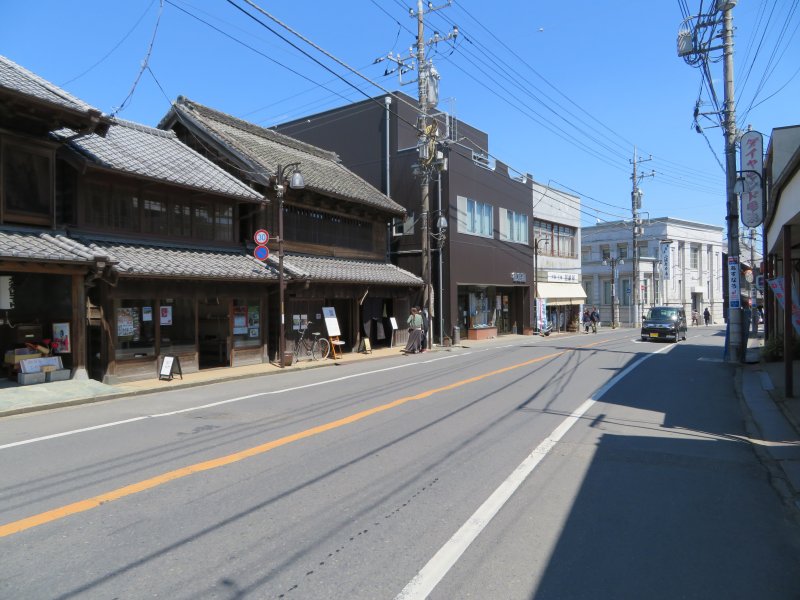 As explained in the article on Hinamatsuri (March), more and more villages
and towns have started to celebrate Hinamatsuri in the communities as an
effort to attract visitors and revitalize the areas. This is a new style
of Hinamatsuri that has emerged from the need to stimulate the local economy.
Although not as popular as Hinamatsuri, certain communities have started
to host similar activities for Childrenfs Day. We went to one such event
in the Sawara district within Katori City in Chiba Prefecture.
As explained in the article on Hinamatsuri (March), more and more villages
and towns have started to celebrate Hinamatsuri in the communities as an
effort to attract visitors and revitalize the areas. This is a new style
of Hinamatsuri that has emerged from the need to stimulate the local economy.
Although not as popular as Hinamatsuri, certain communities have started
to host similar activities for Childrenfs Day. We went to one such event
in the Sawara district within Katori City in Chiba Prefecture.
(Left: High Street of the Sawara district. Note the resemblance to Kawagoe
in Saitama Prefecture. The three areas of Kawagoe, Sawara and Tochigi City
in Tochigi Prefecture are called Koedo or Little Edo.)
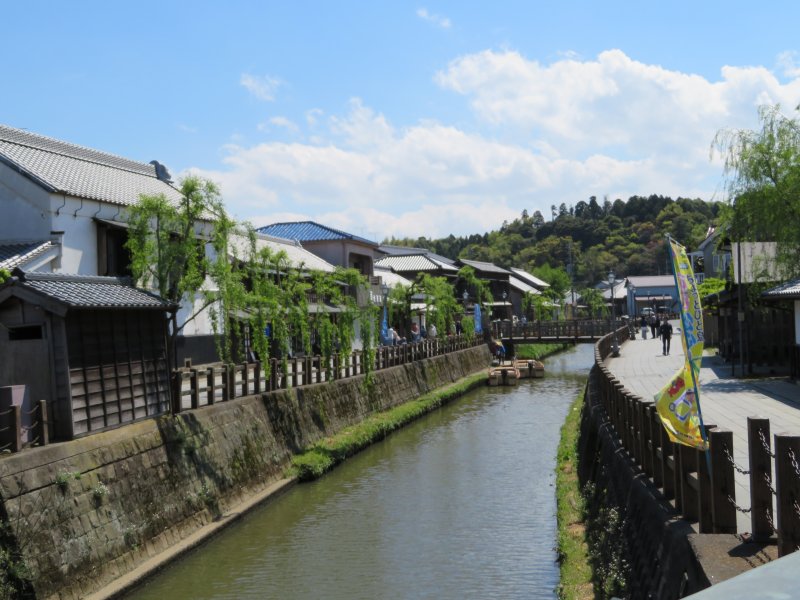 Sawara appears in the article gHow the quest startedh. It is a town now
merged together in 2006 with three other towns into Katori City. Together
with Kawagoe in Saitama Prefecture featured in gTravelh, and Tochigi in
Tochigi Prefecture, Sawara is called Ko-Edo (little Edo) for its resemblance
to how the streets of Edo (now Tokyo) must have looked like in the Edo
era.
Sawara appears in the article gHow the quest startedh. It is a town now
merged together in 2006 with three other towns into Katori City. Together
with Kawagoe in Saitama Prefecture featured in gTravelh, and Tochigi in
Tochigi Prefecture, Sawara is called Ko-Edo (little Edo) for its resemblance
to how the streets of Edo (now Tokyo) must have looked like in the Edo
era.
(Left: The buildings by the river that have most retained the Edo-like
features and designated as Important Preservation District for Groups of
Historic Buildings.Street of the Sawara district.)
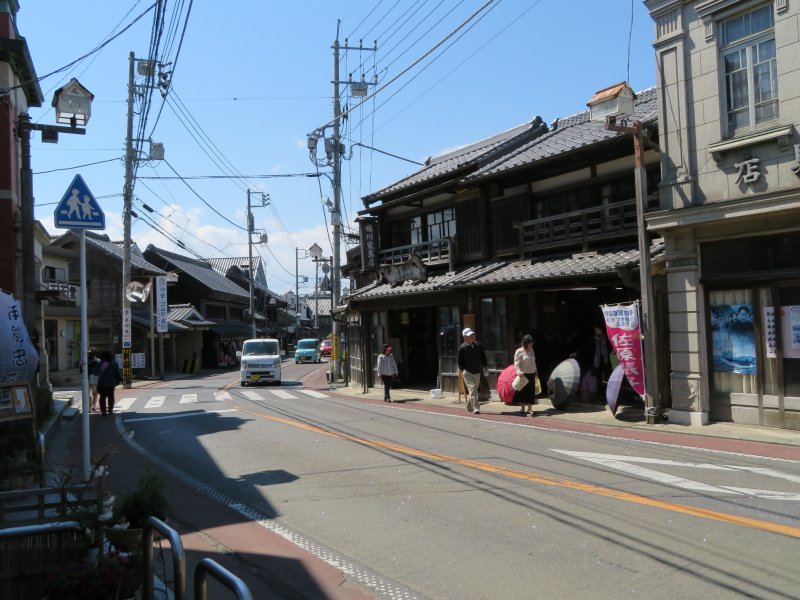 Sawara flourished as a distribution point to collect local products to
be sent to Edo by boat. This continued to the 1930s by which time distribution
to Tokyo had shifted to rail and road. The high street and the streets
by the river are the areas that have most retained the Edo-like features
and designated as Important Preservation District for Groups of Historic
Buildings.
Sawara flourished as a distribution point to collect local products to
be sent to Edo by boat. This continued to the 1930s by which time distribution
to Tokyo had shifted to rail and road. The high street and the streets
by the river are the areas that have most retained the Edo-like features
and designated as Important Preservation District for Groups of Historic
Buildings.
(Left: The buildings on the right were formerly furniture shops. The wooden
structure from the Edo era and the stone structure which is most likely
Taishou or early Shouwa era.)
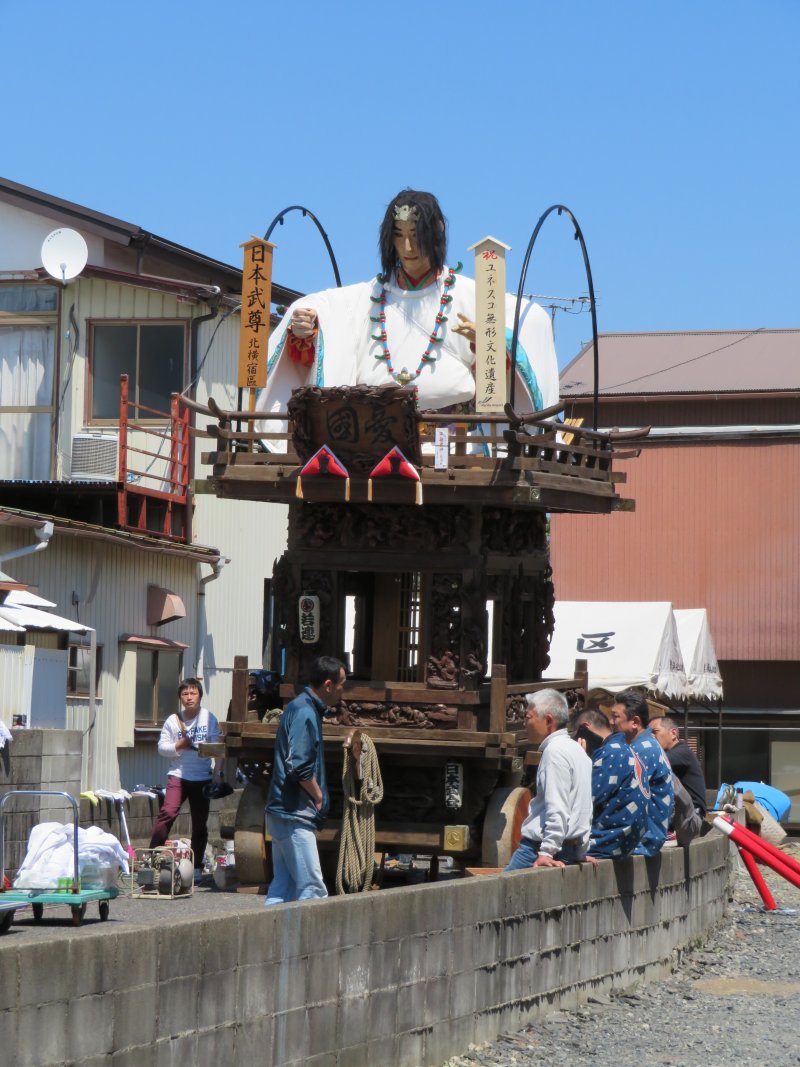 Sawara is also famous for its festivals in July for Obon under the lunar
calendar and October to celebrate the harvest, where the star feature is
the dozen or so floats with human dolls of ancient heroes as much as four
meters tall that are tugged through the streets.
Sawara is also famous for its festivals in July for Obon under the lunar
calendar and October to celebrate the harvest, where the star feature is
the dozen or so floats with human dolls of ancient heroes as much as four
meters tall that are tugged through the streets.
(Left: The gigantic doll of Yamato Takeru-no Mikoto, one of the mythical
founders of Japan is being prepared to appear at a special event to celebrate
the designation of the two Sawara festivals as an UNESCO designated intangible
cultural heritage.)
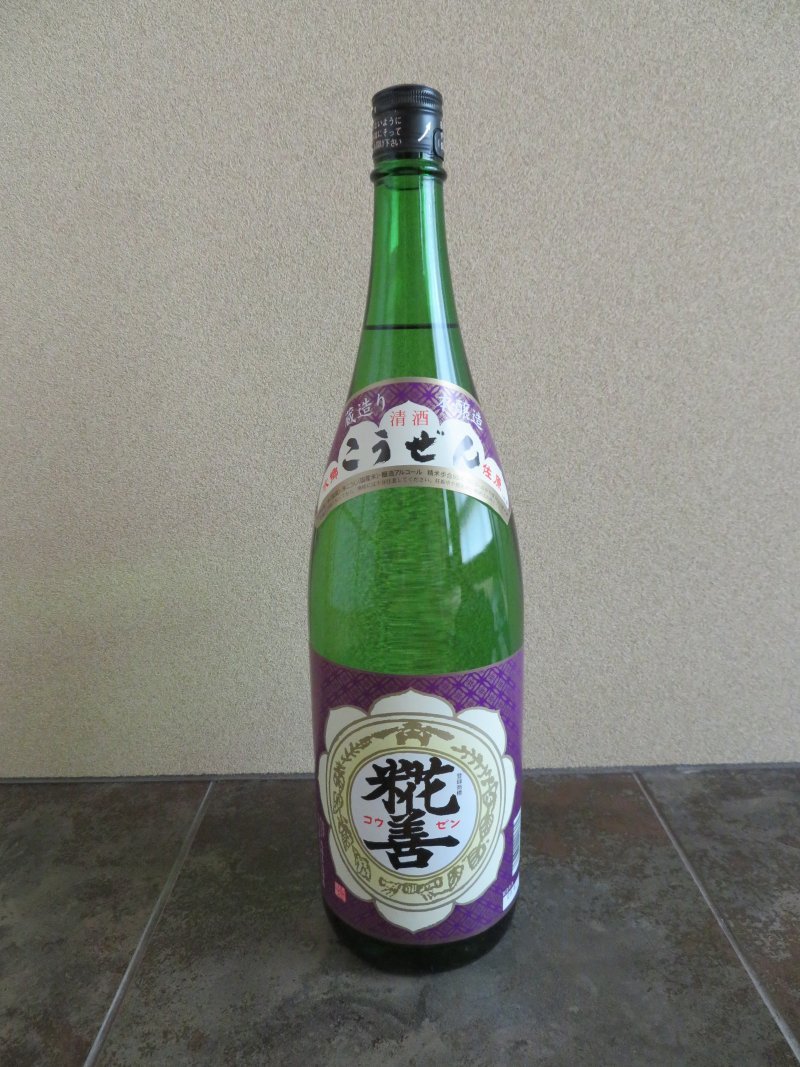 There are also some sake breweries in the area. I purchased a 1.8 liter
bottle of Kouzen honjouzou, which is dry and goes well with all types of
Japanese dishes.
There are also some sake breweries in the area. I purchased a 1.8 liter
bottle of Kouzen honjouzou, which is dry and goes well with all types of
Japanese dishes.
(Left: I purchased a 1.8 liter bottle of Kouzen honjouzou, which is dry
and goes well with all types of Japanese dishes.)
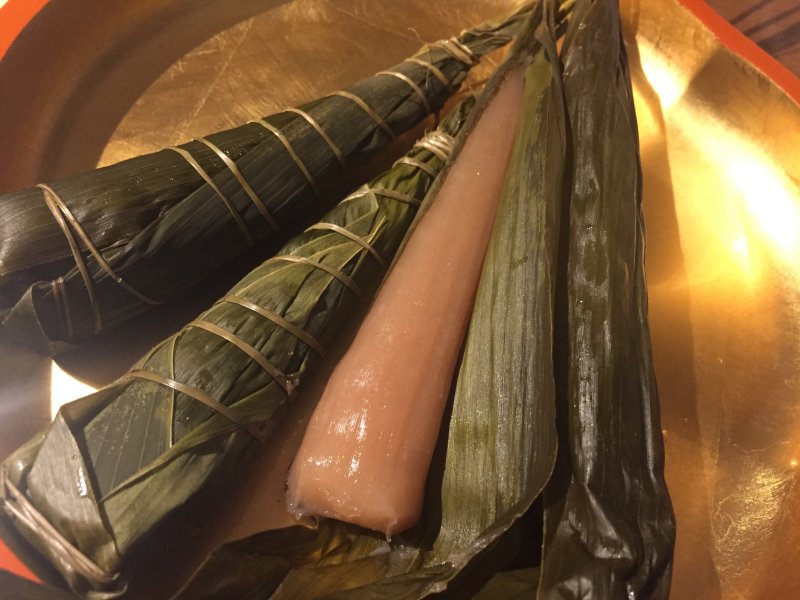 And of course the Wagashi (Japanese sweets) for May is Chimaki. This is
a popular sweets you can find in many countries in the far east. Basically
it is a rice cake wrapped in bamboo leaves.
And of course the Wagashi (Japanese sweets) for May is Chimaki. This is
a popular sweets you can find in many countries in the far east. Basically
it is a rice cake wrapped in bamboo leaves.